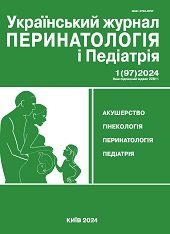The use of vacuum bell therapy for the treatment of pectus excavatum in children of the younger group: the dynamics of changes in echocardiography
DOI:
https://doi.org/10.15574/PP.2024.97.78Keywords:
congenital defects, children, chest deformity, conservative treatment, echocardiography, pediatricsAbstract
Pectus excavatum (PE) si common disease among children, which in most cases manifests during the period of intensive growth. Children with PE may have asymptomatic changes in the heart and may not cause concern for some time.
Purpose - to evaluate of the dynamics of echocardiography changes during conservative treatment of PE by vacuum bell therapy.
Materials and methods. An evaluation of 28 patients with an average age of 6.4±1.2, who underwent conservative treatment of PE, was carried out. Cardiac ultrasound data before and after treatment were processed statistically.
Results. After treatment, signs of mitral valve prolapse in children remained, that is, there were no qualitative changes. But the overall level of prolapse decreased statistically significantly (p=0.042) from 1.97±0.87 mmHg. to 1.73±0.69 mm Hg. Paradoxical movement of the interventricular membrane was not a frequent defect and before treatment was observed only in 5 (17.9%) children. After treatment, this defect was not noted.
Myocardial function in all children was normal (>60%) both before treatment (69.86±8.21%) and after (68.54±2.67%).
Conclusions. In pediatric population disturbances in the work of the heart with PE are often in a compensated or subcompensated state, but in the future they can lead to functional disorders.Screening use of echocardiography is recommended for all children with manifestations of funnel-shaped chest deformity.
The research was carried out in accordance with the principles of the Declaration of Helsinki. The research protocol was approved by the Local Ethics Committee of the institution mentioned in the work. Informed consent of the patients was obtained for the research.
No conflict of interests was declared by the authors.
References
Abid I, Ewais MM, Marranca J, Jaroszewski DE. (2017). Pectus Excavatum: A Review of Diagnosis and Current Treatment Options. J Am Osteopath Assoc. 117(2): 106-113. https://doi.org/10.7556/jaoa.2017.021; PMid:28134952
Acipayam A, Güllü UU, Güngör Ş. (2023). Cardiac anomalies in pediatric patients with pectus excavatum. Rev Assoc Med Bras (1992). 69(7): e20221301. https://doi.org/10.1590/1806-9282.20221301; PMid:37466586 PMCid:PMC10352011
Daemen JHT, de Loos ER, Geraedts TCM, Van Veer H, Van Huijstee PJ, Elenbaas TWO et al. (2022). Visual diagnosis of pectus excavatum: An inter-observer and intra-observer agreement analysis. J Pediatr Surg. 57(3): 526-531. https://doi.org/10.1016/j.jpedsurg.2021.06.003; PMid:34183157
Gürkan U, Aydemir B, Aksoy S, Akgöz H, Tosu AR, Öz D et al. (2014). Echocardiographic assessment of right ventricular function before and after surgery in patients with pectus excavatum and right ventricular compression. Thorac Cardiovasc Surg. 62(3): 231-235. https://doi.org/10.1055/s-0033-1342941; PMid:23619591
Jung Y, Yi E, Lee K, Chung JH, Cho S, Lee S. (2021). Surgical versus Vacuum Bell Therapy for the Correction of Pectus Excavatum: A Comparison of 1-Year Treatment Outcomes. J Chest Surg. 54(6): 473-479. https://doi.org/10.5090/jcs.21.073; PMid:34815370 PMCid:PMC8646059
Koumbourlis AC. (2015). Pectus deformities and their impact on pulmonary physiology. Paediatr Respir Rev. 16(1): 18-24. https://doi.org/10.1016/j.prrv.2014.10.009; PMid:25464892
Kovalenko VM, Sychov OS, Dolzhenko MM, Ivaniv YuA, Nesukai OH, Potashev SV. (2016). Ekhokardiohrafichna otsinka klapannykh stenoziv. Rekomendatsii robochoi hrupy z funktsionalnoi diahnostyky Asotsiatsii kardiolohiv Ukrainy ta Vseukrainskoi asotsiatsii fakhivtsiv z ekhokardiohrafii. URL: https://www.webcardio.org/ekhokardioghrafichna-otsinka-klapannykh-stenoziv.aspx.
Loufopoulos I, Karagiannidis IG, Lampridis S, Mitsos S, Panagiotopoulos N. (2021). Vacuum Bell: Is It a Useful Innovative Device for Pectus Excavatum Correction? Turk Thorac J. 22(3): 251-256. https://doi.org/10.5152/TurkThoracJ.2021.20035; PMid:35110237 PMCid:PMC8975307
Park JM, Varma SK. (1990). Pectus excavatum in children: diagnostic significance for mitral valve prolapse. Indian J Pediatr. 57(2): 219-22. https://doi.org/10.1007/BF02722092; PMid:2246020
St-Louis E, Miao J, Emil S, Baird R, Bettolli M, Montpetit K et al. (2019). Vacuum bell treatment of pectus excavatum: An early North American experience. J Pediatr Surg. 54(1): 194-199. https://doi.org/10.1016/j.jpedsurg.2018.10.011; PMid:30414687
Downloads
Published
Issue
Section
License
Copyright (c) 2024 Ukrainian Journal of Perinatology and Pediatrics

This work is licensed under a Creative Commons Attribution-NonCommercial 4.0 International License.
The policy of the Journal “Ukrainian Journal of Perinatology and Pediatrics” is compatible with the vast majority of funders' of open access and self-archiving policies. The journal provides immediate open access route being convinced that everyone – not only scientists - can benefit from research results, and publishes articles exclusively under open access distribution, with a Creative Commons Attribution-Noncommercial 4.0 international license(СС BY-NC).
Authors transfer the copyright to the Journal “MODERN PEDIATRICS. UKRAINE” when the manuscript is accepted for publication. Authors declare that this manuscript has not been published nor is under simultaneous consideration for publication elsewhere. After publication, the articles become freely available on-line to the public.
Readers have the right to use, distribute, and reproduce articles in any medium, provided the articles and the journal are properly cited.
The use of published materials for commercial purposes is strongly prohibited.

